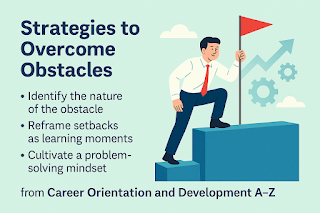Obstacles are a natural part of any personal or professional journey. Whether you're a student struggling with uncertainty, a recent graduate facing a competitive job market, or a professional at a crossroads, the ability to overcome challenges can determine your long-term success.
The book Career Orientation and Development A-Z: Navigating Your Career: An Academic and Practical Roadmap to Career Orientation and Development offers a practical and empowering perspective on how to navigate such roadblocks—not just with tactics, but with purpose and clarity.
Let’s explore some of the core strategies the book presents for overcoming obstacles effectively and with confidence.
1. Identify the Nature of the Obstacle
The book emphasizes the importance of self-assessment. Often, the first barrier to progress is a lack of clarity about the problem itself. Whether it’s internal (fear, self-doubt) or external (lack of resources or direction), identifying what’s truly standing in your way is the first step to overcoming it.
As emphasized in Career Orientation and Development A-Z, “A well-defined problem is already half-solved.”
2. Use Career Mapping as a Strategic Tool
One of the most practical frameworks in the book is career mapping—a technique that helps individuals visualize their goals, current position, and steps needed to move forward. By breaking down long-term aspirations into manageable short-term actions, challenges become less overwhelming and more structured.
This tool encourages planning, reflection, and adaptability—crucial elements when obstacles disrupt your momentum.
3. Reframe Setbacks as Learning Moments
Rather than seeing setbacks as failures, the book invites readers to reinterpret them as valuable learning opportunities. Through case studies and reflective exercises, readers are encouraged to analyze what each challenge is teaching them and how it can contribute to future growth.
“Each obstacle is a disguised opportunity to grow stronger in both competence and character.” — Career Orientation and Development A-Z
4. Strengthen Your Career Capital
Another powerful concept introduced is career capital—a combination of skills, networks, and experiences that increase your value in the workforce. The book advises readers to overcome stagnation by actively investing in new knowledge, certifications, and professional connections.
Building career capital makes you more resilient and better equipped to pivot when faced with sudden challenges.
5. Cultivate a Problem-Solving Mindset
The book promotes a proactive, solutions-oriented mindset. Whether dealing with rejection, burnout, or uncertainty, the key is to approach problems methodically. Identify alternatives, weigh options, seek mentors, and stay flexible.
“Don’t wait for the storm to pass—learn to dance in the rain by preparing your mindset.” — Career Orientation and Development A-Z
Conclusion: Turning Barriers into Bridges
Every obstacle has the potential to strengthen your direction if approached with the right tools. Career Orientation and Development A-Z doesn’t just offer generic advice—it provides an academic and practical roadmap that helps readers transform uncertainty into action and doubt into development.
Whether you’re at the start of your career or seeking reinvention, this book is a guide to move from blocked to bold.

Comments
Post a Comment